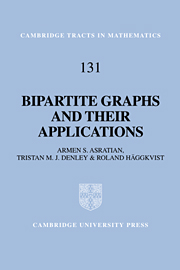Book contents
- Frontmatter
- Contents
- Preface
- Notation
- Chapter 1 Basic concepts
- Chapter 2 Introduction to bipartite graphs
- Chapter 3 Metric properties
- Chapter 4 Connectivity
- Chapter 5 Maximum matchings
- Chapter 6 Expanding properties
- Chapter 7 Subgraphs with restricted degrees
- Chapter 8 Edge colourings
- Chapter 9 Doubly stochastic matrices and bipartite graphs
- Chapter 10 Coverings
- Chapter 11 Some combinatorial applications
- Chapter 12 Bipartite subgraphs of arbitrary graphs
- Appendix
- References
- Index
Chapter 4 - Connectivity
Published online by Cambridge University Press: 05 November 2011
- Frontmatter
- Contents
- Preface
- Notation
- Chapter 1 Basic concepts
- Chapter 2 Introduction to bipartite graphs
- Chapter 3 Metric properties
- Chapter 4 Connectivity
- Chapter 5 Maximum matchings
- Chapter 6 Expanding properties
- Chapter 7 Subgraphs with restricted degrees
- Chapter 8 Edge colourings
- Chapter 9 Doubly stochastic matrices and bipartite graphs
- Chapter 10 Coverings
- Chapter 11 Some combinatorial applications
- Chapter 12 Bipartite subgraphs of arbitrary graphs
- Appendix
- References
- Index
Summary
k-connected graphs
We have already introduced the concept of a graph being connected, now we shall introduce some measure of this connectedness. The vertex connectivity, or simply connectivity k(G), of a graph is defined to be the minimum number of vertices whose removal disconnects the graph, or reduces it to a single vertex; for example k(KP) = p - 1, k(Kn,n) = n and k(T) = 1 for any non-trivial tree T. A set of vertices which disconnects the graph in this way is called a vertex cut. If a vertex cut consists of only one vertex then that vertex is called a cut vertex. It is clear that there is always a vertex cut of cardinality at most δ(G) for any graph, giving an upper bound for the connectivity. If k(G) ≥ k then we say that G is k-connected. To illustrate these concepts, we give the following simple result.
Proposition 4.1.1The n-cube Qn has connectivity n, and furthermore, any minimum vertex cut consists of a vertex neighbourhood.
Proof. The proof is by induction on n. The cases n = 1 and 2 are trivial.
Let n ≥ 3. Since Qn+1 = Qn × K2 it may be partitioned into two copies of Qn, G1 and G2, so that each vertex of G1 has precisely one neighbour in G2.
- Type
- Chapter
- Information
- Bipartite Graphs and their Applications , pp. 45 - 55Publisher: Cambridge University PressPrint publication year: 1998

